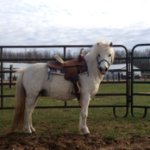This blog is going to be my way to keep you up to date with what is going on at Wind Dancer, and give you a bit of a more personal feel of what it is like to not only run a pony rescue, but to live and work at it every day. It is December now and the nights are getting colder. That makes for beautiful mornings. I feed the ponies on Monday and Thursday mornings. They do get fed every other morning as well – just not by me!
First I go to my own barn, as it is on the way to the rescue. They hear me and call out. Most often they have eaten all of their hay by the morning, and even though there are still bits of grass to graze on, they love to get a new batch of hay every day. In the main paddock there are currently seven ponies, and they jostle for the prime real estate, which is standing at the gate where I am going to enter with the hay.
Now ponies may be small, but they are mighty, and mighty hungry it seems with those round bellies. And although some may think my day as a veterinarian carries a risk of danger, nothing is trickier than that first moment you enter the pony paddock with a wheelbarrow of hay! Beans can be irritable, and he can place those hind feet straight up in the air in an effort to claim his territory. I throw a small bit of hay over the gate to the left – he moves to that spot and defends it against the others. Then I can enter the paddock with another big handful of hay that I distribute into several small piles as I run fast away from the bickering herd. That gives me enough time while they eat their two bites so that I can bring the wheelbarrow through in peace.
I love old Ruben who stands back and watching, with a quiet knowledge that the hay will come – and for him a loving pat too. We fill slow feeders with hay. At a cost of $800 each (thank you donors), these allow our ponies to “graze” on hay throughout the day. Especially in the winter when there is no grass, the slow feeders keep the ponies busy. Without these they would eat their hay quickly and then just stand around all day waiting for their next meal. Instead they have to work the hay out through small holes in the feeder and this takes them some time.
On the topic of hay, it is by far our greatest expense. We feed good quality first cut grass hay and purchase it in large square bales. We have an attachment on the tractor that we use to move these bales and we are putting one bale in our small pony shed every 4-5 days. This is quite a bit of work as first the attachment needs to be put on the tractor and then the bale is picked up and placed in front of the pony shed. Rayna, our wonderful operations assistant, then opens the bale and stacks it flake by flake (or slice by slice) onto the pallets in the shed. With some of the looser bales this can be very labour intensive. Then at feeding times, the volunteers move these flakes to the pony paddocks.
We are hoping to invest in a larger hay storage building at the rescue so that the tractor can drive right through the open doors and stack the bales for the volunteers to use. We would like to be able to store 6-8 bales in this structure and this would eliminate handling the hay twice. As well we would be making much better use of the tractor and Johnny’s time! Such a building will be an expense not covered in our existing budget, so watch for donation requests as we hope to move forward with this project before winter sets in.
Our work couldn’t happen without the ongoing support of our volunteers and donors. We are thankful for that support every day.
Believing in ponies!
Dr. Paula

Comments are closed.